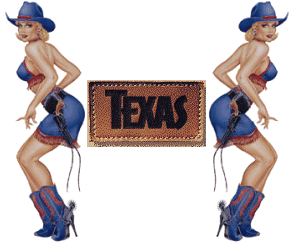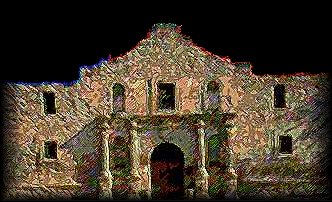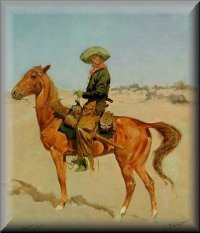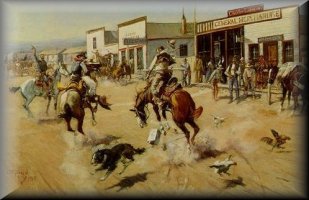

About 10,000 B.C., the first Indians arrived in Texas. These ancient peoples are called Paleo-Indians. They hunted mammoths and giant bison and other animals that later became extinct. After 6,000 B.C., Indian lifeways changed, and archaeologists call the time in Texas from then to about A.D. 500 the Archaic Period. During this period Indians painted beautiful murals depicting human scenes and religious ceremonies on cave walls in dry areas of West Texas.
The years from A.D. 500 to A.D. 1500 are called the Late Prehistoric Period. Agricultural Indians domesticated some of our principal crops, including cotton, corn, beans, squash, tomatoes and potatoes. Burial and temple mounds of these early farmers can be found in the piney woods of East Texas.
Although six flags have flown over Texas, there have been eight
changes of government:
Spanish 1519-1685
French 1685-1690
Spanish 1690-1821
Mexican 1821-1836
Republic of Texas 1839-1845
United States 1845-1861
Confederate States 1861-1865
United States 1865-present
In 1519, the Spanish explorer Pineda made a map of the Texas coast. This event marked the beginning of Spain's rule in Texas. Nine years later, in 1528, Cabeza de Vaca was shipwrecked near Galveston. His small band met many Indian tribes while wandering through the Texas area, but he finally came to a Spanish settlement. He made his way to Mexico City with tales of the fabled "Seven Cities of Gold." In the early 1540s, the explorer Coronado, in an attempt to find the seven cities, trekked through present New Mexico, West Texas and as far north as Kansas. Though he found no cities of gold, he strengthened Spain's claim on Texas. Today, an archaeological site linked to Coronado is being studied by a team of archaeologists in the Texas Panhandle.
Corpus Christi de la Isleta, established near El Paso in 1682, was the first Spanish mission and pueblo in Texas.
The French claim on Texas rests on La Salle's visit in 1685. He established Fort St. Louis in the Matagorda Bay area. Two years later, he was killed by his own men. By 1690, Indians and disease had destroyed the small French force. In 1995, a team of Texas Historical Commission archaeologists discovered the Belle, one of La Salle's frigates, in the murky waters of Matagorda Bay. In 1996, the exact location of Ft. Saint Louis was pinpointed near Victoria. These discoveries represent two of the most important archaeological finds in recent history, and promise to provide many answers to questions about this period in history.

Alarmed by the French presence in Texas and the French settlements in the Louisiana area, the Spaniards established in 1690 Mission San Francisco de los Tejas, the first East Texas mission. In 1718, with the establishment of Mission San Antonio de Valero (the Alamo), the city of San Antonio was founded.
In 1821, the year Mexico gained independence from Spain, Stephen F. Austin received permission from the Mexican government to settle a colony of 300 families, now known as the "Old Three Hundred," in southeast Texas. Although Anglo Americans were already living in Texas at the time, Austin's settlement was the official beginning of Anglo American colonization in Texas. By 1836, 35,000 to 50,000 people had settled in Texas.
Early in 1835, Stephen F. Austin announced that he was convinced that war with Mexico was necessary to secure freedom. Growing tension in Texas was the result of cultural, political and religious differences between the Anglo Americans and the Mexican government. In response to the unrest, Antonio Lopez de Santa Anna, the president of Mexico, reinforced Mexican troops in Texas. A battle fought at Gonzales on Oct. 2, 1835, in which the Mexican forces were thwarted in their efforts to retrieve a cannon, gave rise to the famous flag bearing the words "Come and Take It." Though there were earlier minor skirmishes, the Battle of Gonzales is generally considered to be the first battle for Texas' independence.

The Battle of the Alamo, lasting nearly two weeks, ended on March 6, 1836, with the deaths of all its defenders (numbering about 190). The Mexican army of Santa Anna numbered 4,000 to 5,000 during its final charge. Among those killed were David Crockett, Jim Bowie and William B. Travis. A subsequent massacre of Texans who had surrendered at Goliad on March 27 led to the battle cry of Texas' independence, "Remember the Alamo! Remember Goliad!"
The Texas Declaration of Independence was enacted at "Washington-on-the-Brazos" on March 2, 1836.

The Battle of San Jacinto was fought on April 21, 1836, near the present city of Houston. Santa Anna's entire force of 1,600 men was killed or captured by Gen. Sam Houston's army of 800 Texans; only nine Texans died. This decisive battle resulted in Texas' independence from Mexico.
Sam Houston, a native of Virginia, was president of the Republic of Texas for two separate terms, 1836-1838 and 1841-1844. He also was governor of the state of Texas from 1859 to 1861.

Jos� Antonio Navarro, signer of the Texas Declaration of Independence and one of the framers of the Constitution of the Republic, was a Texas native, born in San Antonio in 1795. He also served in the Republic of Texas Congress and the Constitutional Convention in 1845. Navarro County was named in his honor.
The first Congress of the Republic of Texas convened October 1836 at Columbia (now West Columbia). Stephen F. Austin, known as the "Father of Texas," died Dec. 27, 1836, after serving two months as secretary of state for the new Republic.

In 1836, five sites served as temporary capitals of Texas (Washington-on-the-Brazos, Harrisburg, Galveston, Velasco and Columbia) before Sam Houston moved the capital to Houston in 1837. In 1839, the capital was moved to the new town of Austin.
Texas was annexed to the United States as the 28th state on Dec. 29, 1845.
Texas seceded from the United States and joined the Confederate States of America on Jan. 28, 1861.
Texas officially was readmitted to the Union on March 30, 1870, following the period of Reconstruction.
The present Texas Constitution was ratified on Feb. 15, 1876.
In 1936, Texas celebrated its centennial. Historical markers, placed by the Centennial Commission, later were the basis for the historical marker program of the Texas Historical Commission.
On Nov. 22, 1963, President John F. Kennedy was assassinated during a motorcade through downtown Dallas. Vice-President Lyndon B. Johnson of Texas was sworn in as president aboard the presidential airplane at Dallas' Love Field airport that same day.
There is so much left to tell. However, there is just so much time and space in which to tell it all. Maybe you will find more own your own... if you like.
Thank You...